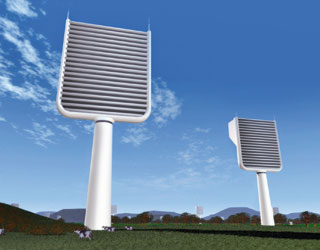In a recent blog, I noted that legislation being voted on today and aimed at controlling greenhouse gas emissions is counting on the fact that technology will be developed that effectively and efficiently captures carbon emissions and stores them underground. The Obama administration supports Congress in its efforts and recently announced that it is restarting a public-private project to capture and store carbon dioxide emissions that was abandoned by the Bush administration [“U.S.-Private Bid to Trap Carbon Emissions Is Revived,” by Kate Galbraith, New York Times, 12 June 2009]. The Bush administration abandoned the project because “costs had doubled to $1.8 billion, from $950 million. A study later found that a math error had caused the increase to be overstated; costs had actually risen 39 percent, to $1.3 billion.” The project goes by the name FutureGen. Even though the U.S. Secretary of Energy, Steven Chu, announced that the project had been resurrected, Galbraith reports that life has not yet been fully breathed into the project.
“The project does not have a green light yet. The Department of Energy said it and FutureGen would make a final decision early next year, after additional cost assessments. For now, the department is estimating government contributions at slightly more than $1 billion, with most of that coming from stimulus money designated for advancing clean coal technologies. The FutureGen Alliance of large coal producers and users will provide $400 million to $600 million.”
If the project receives a green light, “a coal plant will be built in Mattoon, Ill., that will store nearly all of its emissions underground, where they cannot contribute to global warming. … The plant would test techniques for converting coal to a gas, capturing pollutants and burning the gas for power. The carbon dioxide would be compressed and pumped into deep soil layers. Monitoring devices would test whether any had escaped into the air.” During his campaign for president, Mr. Obama expressed his confidence that clean coal technology could be developed and he promised to pursue that technology. Restarting FutureGen represents partial fulfillment of that campaign promise. The Economist warns, however, that “politicians are pinning their hopes for delivery from global warming on a technology that is not quite airtight.” [“Trouble in store,” 7 March 2009 print edition]. The magazine writes:
“The idea that clean coal, or to be more specific, a technology known as carbon capture and storage (CCS), will save the world from global warming has become something of an article of faith among policymakers too. CCS features prominently in all the main blueprints for reducing greenhouse-gas emissions. The Stern Review, a celebrated report on the economics of climate change, considers it “essential”. It provides one of the seven tranches of emissions cuts proposed by Robert Socolow of Princeton University. The International Energy Agency (IEA) reckons the world will need over 200 power plants equipped with CCS by 2030 to limit the rise in average global temperatures to about 3°C—a bigger increase than many scientists would like. … Despite all this enthusiasm, however, there is not a single big power plant using CCS anywhere in the world. Utilities refuse to build any, since the technology is expensive and unproven.”
This is not the first time that I’ve written about doubts surrounding the development of “clean coal” technologies. Read my post entitled The Conundrum of “Clean Coal” for more information. Some environmentalists worry that no carbon capture and storage scheme will be foolproof and that leaks could occur. Such leaks would wipe out years of effort to clean up the environment and mean that billions of dollars would have been wasted. The Economist continues:
“CCS sounds beguilingly simple. It entails isolating carbon dioxide wherever it is produced in large quantities, such as the smokestacks of coal-fired power plants, compressing it and pumping it underground. The oil and chemical industries already use most of the processes that this involves, although not in combination. And oil, gas and salt water seem to stay put in certain rock formations indefinitely, suggesting that carbon dioxide should as well. … In a purely technical sense, CCS looks promising. There are several proven ways to isolate carbon dioxide from fossil fuels, using a variety of combustion techniques and an assortment of chemical ‘scrubbers’ to react with the gas.”
The article also points out that oil companies in the U.S. already have extensive experience moving carbon dioxide through pipes into the ground to pressurize expiring oil fields. All of that sounds very promising, but [and there always seems to be a “but”] the article notes that the long-pole in the tent is cost.
“The chemical steps in the capture consume energy, as do the compression and transport of the carbon dioxide. That will use up a quarter or more of the output of a power station fitted with CCS, according to most estimates. So plants with CCS will need to be at least a third bigger than normal ones to generate the same net amount of power, and will also consume at least a third more fuel. In addition, there is the extra expense of building the capture plant and the injection pipelines. If the storage site is far from the power plant, yet more energy will be needed to move the carbon dioxide.”
There are also health concerns surrounding carbon capture and storage.
“Spills would also be a health risk, since carbon dioxide is heavier than air, and so can build up in low-lying or poorly ventilated spots. Earlier this year, Zurich Financial Services said it would offer insurance for CCS plants and storage sites while they were operating, and for a limited time thereafter. But CCS advocates all assume that governments will eventually take charge of reservoirs, along with all the monitoring costs and legal liabilities. America’s lawmakers went a step further, and agreed to insure the proposed FutureGen plant and to indemnify the firms behind it from all lawsuits arising from leaks.”
Although the article concludes that “for the moment, at least, CCS is mostly hot air,” it does provide examples of projects, like FutureGen, to make it work. Another example is “Vattenfall, a Swedish utility [that] opened the first power plant to incorporate CCS at Schwarze Pumpe, in Germany.” For more about this plant, read my post entitled The Search for Clean Coal. In an accompanying article in the same issue, The Economist discussed technology that removes carbon dioxide directly from the air [“Scrubbing the skies“].
“Some researchers think there might be a simpler way to reduce the level of CO2 in the atmosphere: to build ‘air capture’ machines that, as their name suggests, grab it from the air. This is not as mad as it sounds. After all, such machines already exist: they are used to ‘scrub’ carbon dioxide from the air on board submarines and spacecraft. ‘It has been around for decades, but the only people who cared were at NASA, because too much CO2 in a space shuttle means you die,’ says Matthew Eisaman, a researcher at the Palo Alto Research Centre (PARC) in California. Proponents of air capture propose scaling up such machinery so that it can process the atmosphere directly, extracting the CO2 so that it can be sold for industrial use or stored underground.”
 As the picture that accompanied the article shows, proponents are talking about “industrial-sized” sky scrubbers. The big advantage for sky scrubbers, the article notes, is that they can be located anywhere — not just at the source where CO2 is being generated. This is a big advantage because it could help eliminate miles of pipeline needed to carry CO2 to underground storage facilities. The scrubbers could be built right above the storage facility and pumped directly into the ground. This would reduce both cost and risk. Scrubbers would also capture CO2 emitted by mobile emission sources like cars, trucks, and airplanes.
As the picture that accompanied the article shows, proponents are talking about “industrial-sized” sky scrubbers. The big advantage for sky scrubbers, the article notes, is that they can be located anywhere — not just at the source where CO2 is being generated. This is a big advantage because it could help eliminate miles of pipeline needed to carry CO2 to underground storage facilities. The scrubbers could be built right above the storage facility and pumped directly into the ground. This would reduce both cost and risk. Scrubbers would also capture CO2 emitted by mobile emission sources like cars, trucks, and airplanes.
Since scrubbers could be located anywhere, there is the possibility that developing countries with few resources aside from vast tracts of non-productive land could eventually find wealth by working scrubber farms and monitoring underground storage facilities. Since the scrubbers require power to work, adjacent solar or wind farms could use these same tracts of previously non-productive land to generate and store energy. The article discusses a couple of ways scrubber designs would work:
“Several designs are being developed, but they involve variations on the same theme. In each case air is brought into contact with a ‘sorbent’ material, which binds chemically with the carbon dioxide. The efficiency of this process depends on the surface area of the sorbent, and an easy way to increase the surface area is to spray a liquid sorbent into the air as a fine mist. At PARC, researchers propose building towers several metres high through which the air would be wafted, coming into contact with a sorbent mist. Having absorbed CO2 from the air, the liquid would drain into a chamber where the gas would be extracted from the sorbent by a series of chemical reactions, or by applying an electric current, depending on the system’s design. The sorbent can then be recycled, and the CO2 compressed into liquid form for removal. A group at the University of Calgary, led by David Keith, has already demonstrated an air-capture prototype based on a spray tower. Klaus Lackner, professor of geophysics at Columbia University and a pioneer in the field, has devised another approach that uses a solid sorbent, consisting of thin sheets of material coated with proprietary chemicals. Carbon dioxide is trapped as the air wafts over these sheets, and is then absorbed by liquid chemicals that are washed over the sheets. The CO2 is extracted from the liquid by applying heat. A cupboard-sized prototype (pictured) has already shown that the concept will work, and Dr Lackner is a member of a company, Global Research Technologies (GRT), that hopes to commercialise the technology. A machine the size of a standard shipping container, he estimates, could capture one tonne of CO2 a day.”
Current estimates are that about 36.7 gigatons of carbon dioxide are emitted each year. Of course, not all of those emissions must be dealt with by scrubbers; but it doesn’t take a math genius to know that a lot of scrubbers would be needed to deal with the problem if no other technologies were also in place. Cost is again the long pole in the tent. Some of those costs could be offset by placing scrubbers next to plants that require carbon dioxide for commercial uses. “By mass,” the article reports, “carbon dioxide is in fact the 19th most important commodity chemical in America, according to the Department of Energy.” Still, the article notes, that unless the cost per ton of capturing carbon dioxide can be reduced to below the cost of a permit that allows the release of a ton of CO2 the project is probably doomed. Currently, a scrubber can produce a ton of CO2 for about $200, while a permit to release a ton of carbon dioxide recently fell below $10. That’s a big cost deficit to overcome.




